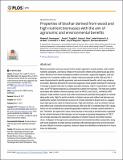Por favor, use este identificador para citar o enlazar a este item:
http://hdl.handle.net/10261/199449COMPARTIR / EXPORTAR:
 SHARE
BASE SHARE
BASE
|
|
| Visualizar otros formatos: MARC | Dublin Core | RDF | ORE | MODS | METS | DIDL | DATACITE | |

| Título: | Properties of biochar derived from wood and high-nutrient biomasses with the aim of agronomic and environmental benefits |
Autor: | Domingues, Rimena R.; Trugilho, Paulo F.; Silva, Carlos A.; de Melo, Isabel Cristina N. A.; Melo, Leônidas C. A.; Magriotis, Zuy, M.; Sánchez-Monedero, Miguel Ángel CSIC ORCID | Fecha de publicación: | 11-may-2017 | Editor: | Plos One | Citación: | PLoS ONE | Resumen: | Biochar production and use are part of the modern agenda to recycle wastes, and to retain nutrients, pollutants, and heavy metals in the soil and to offset some greenhouse gas emissions. Biochars from wood (eucalyptus sawdust, pine bark), sugarcane bagasse, and substances rich in nutrients (coffee husk, chicken manure) produced at 350, 450 and 750˚C were characterized to identify agronomic and environmental benefits, which may enhance soil quality. Biochars derived from wood and sugarcane have greater potential for improving C storage in tropical soils due to a higher aromatic character, high C concentration, low H/C ratio, and FTIR spectra features as compared to nutrient-rich biochars. The high ash content associated with alkaline chemical species such as KHCO3 and CaCO3, verified by XRD analysis, made chicken manure and coffee husk biochars potential liming agents for remediating acidic soils. High Ca and K contents in chicken manure and coffee husk biomass can significantly replace conventional sources of K (mostly imported in Brazil) and Ca, suggesting a high agronomic value for these biochars. High-ash biochars, such as chicken manure and coffee husk, produced at low-temperatures (350 and 450˚C) exhibited high CEC values, which can be considered as a potential applicable material to increase nutrient retention in soil. Therefore, the agronomic value of the biochars in this study is predominantly regulated by the nutrient richness of the biomass, but an increase in pyrolysis temperature to 750˚C can strongly decrease the adsorptive capacities of chicken manure and coffee husk biochars. A diagram of the agronomic potential and environmental benefits is presented, along with some guidelines to relate biochar properties with potential agronomic and environmental uses. Based on biochar properties, research needs are identified and directions for future trials are delineated. | Descripción: | Contiene material suplementario | Versión del editor: | https://journals.plos.org/plosone/article?id=10.1371/journal.pone.0176884#sec022 | URI: | http://hdl.handle.net/10261/199449 |
| Aparece en las colecciones: | (CEBAS) Artículos |
Ficheros en este ítem:
| Fichero | Descripción | Tamaño | Formato | |
|---|---|---|---|---|
| journal.pone.0176884.pdf | Main article | 3,64 MB | Adobe PDF |  Visualizar/Abrir |
CORE Recommender
Page view(s)
228
checked on 18-abr-2024
Download(s)
160
checked on 18-abr-2024
Google ScholarTM
Check
NOTA: Los ítems de Digital.CSIC están protegidos por copyright, con todos los derechos reservados, a menos que se indique lo contrario.
